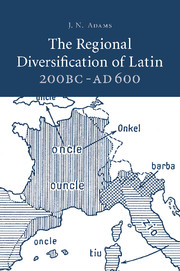Book contents
- Frontmatter
- Contents
- List of maps
- Preface
- List of abbreviations
- Chapter I Introduction
- Chapter II The Republic: inscriptions
- Chapter III Explicit evidence for regional variation: the Republic
- Chapter IV Explicit evidence: the Empire
- Chapter V Regionalisms in provincial texts: Gaul
- Chapter VI Spain
- Chapter VII Italy
- Chapter VIII Africa
- Chapter IX Britain
- Chapter X Inscriptions
- Chapter XI Conclusion
- Maps
- Bibliography
- Index verborum
- Subject index
- Index locorum
Chapter VI - Spain
Published online by Cambridge University Press: 22 September 2009
- Frontmatter
- Contents
- List of maps
- Preface
- List of abbreviations
- Chapter I Introduction
- Chapter II The Republic: inscriptions
- Chapter III Explicit evidence for regional variation: the Republic
- Chapter IV Explicit evidence: the Empire
- Chapter V Regionalisms in provincial texts: Gaul
- Chapter VI Spain
- Chapter VII Italy
- Chapter VIII Africa
- Chapter IX Britain
- Chapter X Inscriptions
- Chapter XI Conclusion
- Maps
- Bibliography
- Index verborum
- Subject index
- Index locorum
Summary
INTRODUCTION
The Carthaginians were driven out of Spain in 206 BC by P. Cornelius Scipio Africanus. By 205 ‘Rome held a narrow east coastal strip (Hispania Citerior) carrying the main road south to Carthago Nova, and beyond it a territory (Hispania Ulterior) including the south-east coast and the Baetis (Guadalquiuir) valley’ (M. I. Henderson, OCD2 s.v. ‘Spain’). In 197 two new praetors were created for Spain. Both provinces were gradually extended inland amid protracted fighting, and after the Lusitanian (155–139 BC) and Celtiberian (155–133 BC) wars about two-thirds of the peninsula was in Roman hands. Spain was thus one of the earliest territories occupied by the Romans, and this fact underlies the main issue that has arisen in the discussion of Spanish Latin. Ibero-Romance is said to be ‘conservative’ or ‘archaic’, and such ‘archaism’ is thought to reflect the character of the Latin language when it first reached the peninsula in the late third and early second centuries BC (for details of this theory see the next section).
A theory of this kind is based on the assumption that Latin took root in Spain in this early period and was in continuous use thereafter. But is the assumption reasonable? For decades after 218 the main group of Latin speakers in Spain would have been soldiers, and military units constantly came and went.
- Type
- Chapter
- Information
- The Regional Diversification of Latin 200 BC - AD 600 , pp. 370 - 431Publisher: Cambridge University PressPrint publication year: 2007



